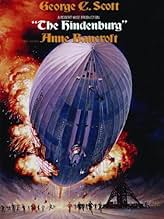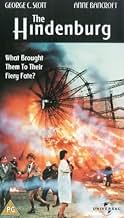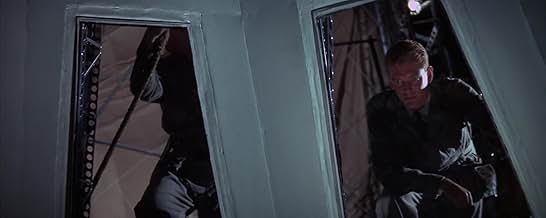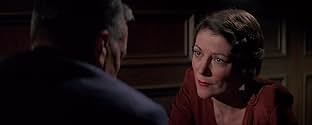IMDb-BEWERTUNG
6,3/10
6924
IHRE BEWERTUNG
Ein Film, der die Ereignisse der Hindenburg-Katastrophe schildert, bei der ein Zeppelin in Flammen aufging.Ein Film, der die Ereignisse der Hindenburg-Katastrophe schildert, bei der ein Zeppelin in Flammen aufging.Ein Film, der die Ereignisse der Hindenburg-Katastrophe schildert, bei der ein Zeppelin in Flammen aufging.
- Für 3 Oscars nominiert
- 2 Gewinne & 4 Nominierungen insgesamt
Richard Dysart
- Lehmann
- (as Richard A. Dysart)
Empfohlene Bewertungen
The 1970's were the age of the disaster films. Films featuring man made and natural calamaties with flashy special effects and big name stars were the "in" thing back then. Irwin Allen was the master of these when he made The Posiedon Adventure and The Towering Inferno. Jennings Lang also made an epic disaster film with Earthquake. In 1975, Robert Wise got into the act with The Hindenburg. Wise is one of our finest directors and I was so happy when he won the American Film Institute's Lifetime Achievement Award several years ago. Everyone loves a good mystery and the Hindenburg disaster is certainly one of them. What caused the explosion? We will probably never know. What we do know is that politics had a lot to do with it. The Hindenburg was filled with volatile hydrogen gas instead of helium. Helium is so safe it would actually smother fire. The American government did not wish to give the Germans helium because they feared they would use it for military purposes. This film has a first class cast with George C. Scott leading the way as the heroic Colonel Franz Ritter. Only a fine actor like Scott could have made a Nazi likeable. There are so many other fine thespians in the cast like Anne Bancroft and Charles Durning (as the Captain). A very fine character actor named William Atherton is the rigger who plants the bomb. Wise is a master of suspense because we all know what is going to happen and the ship is going to blow up, and yet you are on the edge of your seat as Ritter desperately races time to find the bomb. I would also like to mention how much I enjoyed Wise's masterful use of actual film footage of the disaster which he intermingles with scenes of the various actors trying to escape the burning ship. One of the fun things about these disaster films is watching who lived and who died at the end (what is really funny is that those near the top of the cast usually lived the longest!). There was indeed a theory that a rigger on the airship named Eric Spehl (they called him Karl Boerth in the movie) had indeed sabotaged the Hindenburg. The surviving crew members said that they had heard a sudden pop over their heads and looked up to see a circle of bright light that looked like a flashbulb igniting. It was near the axial gangway and this rigger was one of only a few who had acess to it. Spehl was known to have anti Nazi views. Did he plant a bomb? The theory is that Spehl had timed his explosive device (really a flashbulb attached to a photographic timer) to go off after the airship had landed. But the landing was delayed by a storm and he could not get back in time to re set it. Spehl was killed in the disaster and thus we will never know. The most chilling part of this film is where they play Herb Morrisons recording. He was the WLS Chicago reporter who was there to witness a routine airship landing and instead it was one of the most famous recordings ever made. Morrison lived until 1988 and resided near my home in West Virginia.
The director, Robert Wise, made a very good movie on the Zeppelin disaster, the Hinderburg. The movie's only flaw is that almost everyone has an American accent. The language familiarity looses authenticity. You can't tell the difference from the Americans to the Germans. The American actors should have used German accents.
The superb cast is headed by George C. Scott,Anne Bancroft, and Charles Durning. It is fun to see many television actors get their chance to be in a good movie. Rene Auberjonois, Robert Clary, Roy Thinnes, and Joanne Cook Moore shine. Only William Atherton was able to make several good movies as a supporting actor.
After all these years, nobody knows the truth on the Hindenburg disaster. However, the movie tells an interesting story. The movie's version sounds compelling. They claim the Hinderburg was blown up by a saboteur.
The superb cast is headed by George C. Scott,Anne Bancroft, and Charles Durning. It is fun to see many television actors get their chance to be in a good movie. Rene Auberjonois, Robert Clary, Roy Thinnes, and Joanne Cook Moore shine. Only William Atherton was able to make several good movies as a supporting actor.
After all these years, nobody knows the truth on the Hindenburg disaster. However, the movie tells an interesting story. The movie's version sounds compelling. They claim the Hinderburg was blown up by a saboteur.
This film is a unique illustration of the Hindenberg disaster, which occurred on the evening of May 6, 1937 in Lakehurst, New Jersey when the gigantic hydrogen-filled zeppelin exploded on landing. Although a common theory for this event's cause was a discharge of electricity from the atmosphere triggering the fire, here it is suggested as form sabotage. As a result of the explosion, 36 people (one third of those on-board the German airship) were killed.
The movie goes along quite well in the way it is presented as a series of chronological events leading up to the explosion. The cast is flawless and in turn so is the superb and vivid acting. George C. Scott (as Colonel Franz Ritter, a German security officer) and Anne Bancroft (as the reluctant Countess) seem to be very suited and prepared for their parts as the main characters in the film. Other passengers to watch for include: Gig Young (as the sly Edward Douglass), Burgess Meredith (as gambler Emilio Pajetta) and Robert Clary, from the hit sitcom, "Hogan's Heroes", (as Joseph Spahn, a comedian.) These and many others provide an enjoyable overall performance in the movie while not only based on historical accounts, also provides other common genres of drama, suspense, comedy and even elements of romance between the two main characters.
This film may have a general theme of seriousness, as Colonel Ritter proceeds to investigate an array of people aboard who are suspects to an anti-Nazi conspiracy, yet it also resolves to make way for other moods as well. For example, midway through the film there is a very amusing sequence in which passenger Reed Channing (Peter Donat) plays on the airship's famous baby grand piano and sings a song entitled: "There's A Lot to be Said for the Fuhrer" while Joe Spahn performs. This scene obviously demonstrates how both passengers are clearly against the Nazi party, and here it is also interesting to note that during WWII, actor Robert Clary actually was confined to the Nazi concentration camps as countless other unfortunates were subject to during the Holocaust. There are also several humorous one-liners spoken throughout the film, such as: "Next time we'll take the Titanic!" followed by other memorable quotes.
As the film progresses, complications arise in the piloting of the Hindenberg as the crew and passengers encounter a brief experience with turbulence and St. Elmo's fire, (a flickering bluish glow sometimes appearing during storms) and repairing a rip in the fabric cover on the port side of the airship as it hovers over the frigid Atlantic Ocean. Events such as these, and Colonel Ritter's continuing investigation, prove to bring together desired elements of suspense, which certainly add up nearing the movie's climax ending.
Shortly before the Hindenberg's doomed landing, Ritter finally discovers the suspected sabotage and the passenger behind it in a perplexing turn of events. In doing so, he also finds that this well-planned demolition is i n the form of a timed-bomb that has been hidden in the airship's structure and that it is up to him to reach in time for deactivation. The last few thrilling seconds before the explosion in which Colonel Ritter slowly struggles to defuse the bomb have enough apprehension to make it seem an eternity as he meticulously works, but to no avail. From the moment in which the bomb goes off, there is enough action to keep you on the edge of your seat until the movie's end. The last few minutes (which combine both color, black and white images, and still frames of the fire as innocent passengers attempt to escape the flames) are exceedingly well filmed as well as both exciting and horrific. Through this vivid portrayal, one may wonder just what it would have been like to witness this tragic disaster. To any viewer its plain to see just why "The Hindenberg" received a special achievements award for its sound and visual effects and nominations for best cinematography and film editing.
With excellent writing credits provided by Nelson Gidding and under the careful direction of Robert Wise "The Hindenberg" proves to be a genuine and enjoyable movie to watch. This is a film that will undeniably age well, still seeming as timeless as it was the first time through. One of my favorite movies of all time, "The Hindenberg" can be highly recommended.
The movie goes along quite well in the way it is presented as a series of chronological events leading up to the explosion. The cast is flawless and in turn so is the superb and vivid acting. George C. Scott (as Colonel Franz Ritter, a German security officer) and Anne Bancroft (as the reluctant Countess) seem to be very suited and prepared for their parts as the main characters in the film. Other passengers to watch for include: Gig Young (as the sly Edward Douglass), Burgess Meredith (as gambler Emilio Pajetta) and Robert Clary, from the hit sitcom, "Hogan's Heroes", (as Joseph Spahn, a comedian.) These and many others provide an enjoyable overall performance in the movie while not only based on historical accounts, also provides other common genres of drama, suspense, comedy and even elements of romance between the two main characters.
This film may have a general theme of seriousness, as Colonel Ritter proceeds to investigate an array of people aboard who are suspects to an anti-Nazi conspiracy, yet it also resolves to make way for other moods as well. For example, midway through the film there is a very amusing sequence in which passenger Reed Channing (Peter Donat) plays on the airship's famous baby grand piano and sings a song entitled: "There's A Lot to be Said for the Fuhrer" while Joe Spahn performs. This scene obviously demonstrates how both passengers are clearly against the Nazi party, and here it is also interesting to note that during WWII, actor Robert Clary actually was confined to the Nazi concentration camps as countless other unfortunates were subject to during the Holocaust. There are also several humorous one-liners spoken throughout the film, such as: "Next time we'll take the Titanic!" followed by other memorable quotes.
As the film progresses, complications arise in the piloting of the Hindenberg as the crew and passengers encounter a brief experience with turbulence and St. Elmo's fire, (a flickering bluish glow sometimes appearing during storms) and repairing a rip in the fabric cover on the port side of the airship as it hovers over the frigid Atlantic Ocean. Events such as these, and Colonel Ritter's continuing investigation, prove to bring together desired elements of suspense, which certainly add up nearing the movie's climax ending.
Shortly before the Hindenberg's doomed landing, Ritter finally discovers the suspected sabotage and the passenger behind it in a perplexing turn of events. In doing so, he also finds that this well-planned demolition is i n the form of a timed-bomb that has been hidden in the airship's structure and that it is up to him to reach in time for deactivation. The last few thrilling seconds before the explosion in which Colonel Ritter slowly struggles to defuse the bomb have enough apprehension to make it seem an eternity as he meticulously works, but to no avail. From the moment in which the bomb goes off, there is enough action to keep you on the edge of your seat until the movie's end. The last few minutes (which combine both color, black and white images, and still frames of the fire as innocent passengers attempt to escape the flames) are exceedingly well filmed as well as both exciting and horrific. Through this vivid portrayal, one may wonder just what it would have been like to witness this tragic disaster. To any viewer its plain to see just why "The Hindenberg" received a special achievements award for its sound and visual effects and nominations for best cinematography and film editing.
With excellent writing credits provided by Nelson Gidding and under the careful direction of Robert Wise "The Hindenberg" proves to be a genuine and enjoyable movie to watch. This is a film that will undeniably age well, still seeming as timeless as it was the first time through. One of my favorite movies of all time, "The Hindenberg" can be highly recommended.
If a film about The Hindenburg had to be made it certainly would have been made in the decade of the disaster film, the Seventies. But this film labored under a unique handicap that none of the other disaster films of the decade had.
Unlike the sinking of the Titanic or the blowing up of Mount Krakatoa and certainly not like any of the potential but fictional disaster events that were film subjects, The Hindenburg was recorded on sight with newsreel cameras and on radio with Herbert Morrison's never to be forgotten broadcast. A lot of people now still remember it, let alone back in 1975.
What Robert Wise did and maybe more successfully than any other director was make full use of the famous newsreel footage and carefully edited it into his film, with slow motion techniques into the personal attempts by the cast to try and escape the holocaust. The Hindenburg received Oscar nominations for sound, cinematography, and art&set design with a special award for special effects. Yet no nomination for editing which the main plus this film has going for it.
Of course we don't know what ever really happened to the Hindenburg and the film takes account of all the theories put forth. It also uses the real names of the people who were passengers, crew, and officials of the Third Reich. The Nazi government had a big stake in the dirigible fleet they had built, they were as much propaganda value for them as Max Schmeling in boxing and Gottfried Von Cramm in tennis.
Of course had they had access to helium to float the big guys this might never have happened. But the USA had a near total monopoly on the world's helium and was not selling it to Hitler. Hence they used the lighter, but flammable hydrogen with the result of the tragedy.
George C. Scott and Anne Bancroft head the cast as a Luftwaffe official and a worldly old world countess traveling to the USA to visit her deaf mute daughter going to school for same in Boston. The Nazis didn't believe in helping those they considered defectives, another lovable quality about them.
The Hindenburg is a sobering and near factual account of what happened in Lakehurst, New Jersey that afternoon. It's one of the best of the Seventies disaster films and should not be missed.
Unlike the sinking of the Titanic or the blowing up of Mount Krakatoa and certainly not like any of the potential but fictional disaster events that were film subjects, The Hindenburg was recorded on sight with newsreel cameras and on radio with Herbert Morrison's never to be forgotten broadcast. A lot of people now still remember it, let alone back in 1975.
What Robert Wise did and maybe more successfully than any other director was make full use of the famous newsreel footage and carefully edited it into his film, with slow motion techniques into the personal attempts by the cast to try and escape the holocaust. The Hindenburg received Oscar nominations for sound, cinematography, and art&set design with a special award for special effects. Yet no nomination for editing which the main plus this film has going for it.
Of course we don't know what ever really happened to the Hindenburg and the film takes account of all the theories put forth. It also uses the real names of the people who were passengers, crew, and officials of the Third Reich. The Nazi government had a big stake in the dirigible fleet they had built, they were as much propaganda value for them as Max Schmeling in boxing and Gottfried Von Cramm in tennis.
Of course had they had access to helium to float the big guys this might never have happened. But the USA had a near total monopoly on the world's helium and was not selling it to Hitler. Hence they used the lighter, but flammable hydrogen with the result of the tragedy.
George C. Scott and Anne Bancroft head the cast as a Luftwaffe official and a worldly old world countess traveling to the USA to visit her deaf mute daughter going to school for same in Boston. The Nazis didn't believe in helping those they considered defectives, another lovable quality about them.
The Hindenburg is a sobering and near factual account of what happened in Lakehurst, New Jersey that afternoon. It's one of the best of the Seventies disaster films and should not be missed.
On the 6th of May 1937 The Hindenburg Zeppelin, whilst attempting to dock at Lakehurst Naval Air Station, New Jersey, burst in to flames. Thirty Six people were killed that fateful day, this is a fictionalised account of what may have happened that day.
There are quite a few theories as to what caused the Hindenburg disaster, this film takes the sabotage angle and thankfully (to me) it makes for a very engrossing picture full of tension, drama and no little horror. The 70s was a time for disaster pictures, it seemed that one was churned out every year, not all were great movies for sure, but some actually were viable entertainment, and with The Hindenburg we get good old fashioned story telling, character build up and the pay off actually, well, pays off!
Running at just over two hours long, first time viewers should be aware that for a good 100 minutes of the film it's all about the set up, there are characters to meet and journey motives to explore, all passengers are under suspicion, and we live thru this courtesy of George C Scott's (wonderful here as usual), Col. Franz Ritter, the man assigned to ensure no sabotage can take away the pride of Germany. The film has flaws for sure, the array of passengers are the usual disaster picture assortment of beings, and of course some situations beggar belief, but this is a disaster flick after all, and director Robert Wise pulls it all together nicely for the films finale, and what a finale it is. Using stop frames, and inter cutting film of the actual disaster itself, the finale grips with a sense of realism, the plot line may well be merely one of the reasons put forward, but the crash is indeed a thing of fact, and it closes the film in a very sombre and impacting way. 7/10
There are quite a few theories as to what caused the Hindenburg disaster, this film takes the sabotage angle and thankfully (to me) it makes for a very engrossing picture full of tension, drama and no little horror. The 70s was a time for disaster pictures, it seemed that one was churned out every year, not all were great movies for sure, but some actually were viable entertainment, and with The Hindenburg we get good old fashioned story telling, character build up and the pay off actually, well, pays off!
Running at just over two hours long, first time viewers should be aware that for a good 100 minutes of the film it's all about the set up, there are characters to meet and journey motives to explore, all passengers are under suspicion, and we live thru this courtesy of George C Scott's (wonderful here as usual), Col. Franz Ritter, the man assigned to ensure no sabotage can take away the pride of Germany. The film has flaws for sure, the array of passengers are the usual disaster picture assortment of beings, and of course some situations beggar belief, but this is a disaster flick after all, and director Robert Wise pulls it all together nicely for the films finale, and what a finale it is. Using stop frames, and inter cutting film of the actual disaster itself, the finale grips with a sense of realism, the plot line may well be merely one of the reasons put forward, but the crash is indeed a thing of fact, and it closes the film in a very sombre and impacting way. 7/10
Wusstest du schon
- WissenswertesThe actual site of the Hindenburg crash, at Lakehurst Naval Air Station (now part of Joint Base Lakehurst-Dix-McGuire) is marked with a chain-outlined pad and bronze plaque where the airship's gondola landed. It was dedicated on May 6, 1987, the 50th anniversary of the disaster. Hangar #1, which still stands, is where the airship was to be housed after landing. It was designated a National Historic Landmark in 1968.
- PatzerThe incident depicting the Hindenburg's crew repairing the tear in the Zeppelin's cover as it drifts lower and lower over the Atlantic is factual; however, the event occurred on the Graf Zeppelin, not the Hindenburg.
- Zitate
Mrs. Channing: Sugar, next time, let's take the Titanic.
- Crazy CreditsThe film opens with the 1936 Universal logo followed by a newsreel prior to the credits.
- Alternative VersionenDeleted scenes were added back into the film for television airings, including one in which Goebbels shows Ritter a display of items used in attempted anti-Nazi attacks, including a bomb found on board the ocean liner "Bremen".
- VerbindungenEdited into Jäger des verlorenen Schatzes (1981)
- SoundtracksThere's a Lot To Be Said for the Fuehrer
Music by David Shire
Lyric by Ed Kleban (as Edward Kleban)
Performed by Peter Donat (uncredited), Robert Clary (uncredited)
Top-Auswahl
Melde dich zum Bewerten an und greife auf die Watchlist für personalisierte Empfehlungen zu.
- How long is The Hindenburg?Powered by Alexa
Details
- Erscheinungsdatum
- Herkunftsland
- Sprache
- Auch bekannt als
- The Hindenburg
- Drehorte
- Marine Corps Air Station Tustin, Tustin, Kalifornien, USA(used for Naval Air Station Lakehurst - airship hangers still standing in 2022)
- Produktionsfirma
- Weitere beteiligte Unternehmen bei IMDbPro anzeigen
Box Office
- Budget
- 15.000.000 $ (geschätzt)
- Laufzeit2 Stunden 5 Minuten
- Farbe
- Seitenverhältnis
- 2.35 : 1
Zu dieser Seite beitragen
Bearbeitung vorschlagen oder fehlenden Inhalt hinzufügen






































